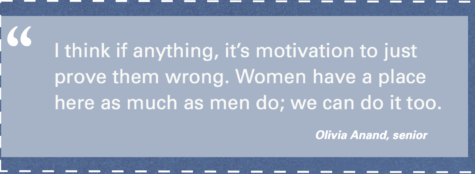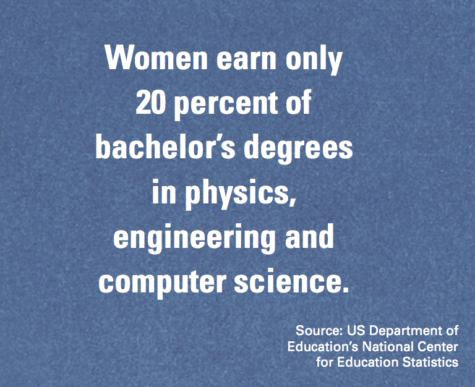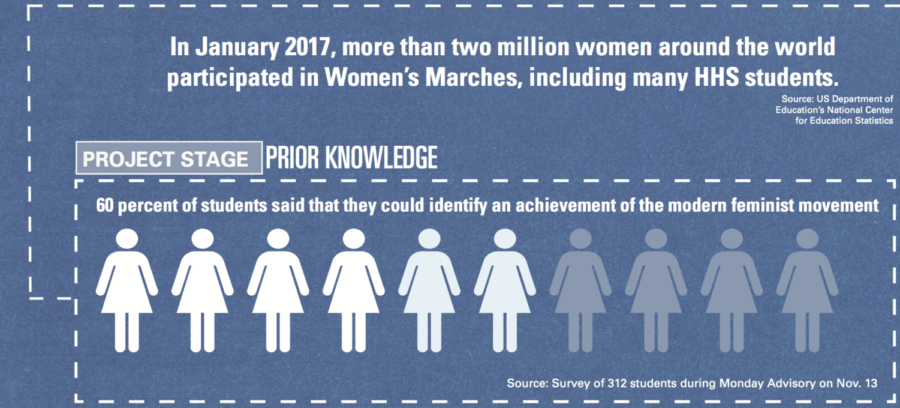The STEMinists
Nov 29, 2017
Walking into HHS’ Anatomy and Physiology class, it may be hard to believe that the same course had been previously dominated by male students and educators.
For Olivia Anand, senior, the progressive shift in demographics was one that did not have a significant impact on her future ambitions.
“In my class, at least, we have two guys and the rest of us are all females, so it just kind of feels natural and I definitely feel like that’s going to be more of a trend…more girls in science classes,” Anand said.
Currently, girls are earning high school math and science credits at the same rate as boys and are earning slightly higher grades in these classes, according to the US Department of Education.
Despite this shift, women are much less likely than men to say that they intend to major in science, technology, engineering, or math (STEM) among first-year college students, according to the U.S. Department of Education, National Center for Education Statistics, 2007.
In order to ensure that females are encouraged to participate in STEM courses and are accurately represented in their respective fields, Anand believes that advocacy is key.
“I feel like maybe not with Anatomy, but maybe with physical sciences like physics, it feels like the more male-dominant side of the sciences, and probably higher level math too,” Anand said. “It’s available, but not very advocated for women to take physics or calculus.”
Hearing about the experiences of her teacher, Ms. Alyson Purdy, Science, has brought light to the significant role female educators in the STEM field. These significant roles has been critical in advancing greater gender equality in the workplace.
“She’s told us about how she came from a small town and she was the only woman scientist,” Anand said. “At conferences, people would just come and stare at her because she was the only woman science teacher and she was young, and it was just so different. Now, that’s normal.”
Now that the notion of a female science teacher is considered conventional, Purdy has attempted to take this concept one step further. When schedules are made during the summer, Purdy is a strong advocate for female representation in every area of science, from physics to biology.
“Girls need to see themselves represented in all areas of science. I think that’s the biggest thing, girls now are confident of their abilities more than ever before, are very aware that people are shattering glass ceilings all over the place,” Purdy said. “But at the end of the day, those people are still very far away. We have to make every effort that girls, and the parents of girls, see real people right here right now doing what the girls may be interested in.”
Outside of the classroom, Purdy is also one of the mentors of HHS’ robotics club, the Technocrats. Robotics competitions tend to be a testosterone-rich environment, and Purdy has occasionally had other mentors doubt her abilities. She attributes this, in part, to her gender identity.
“When I go to a robotics tournament here in Minnesota, I am one of very few lead mentors that are female in the state of Minnesota. When we go to world championships, the proportion gets even lower. It’s unusual. I feel like, in a 30-some-year career here, they really should’ve caught up by now,” Purdy said.
 Debra Chepkemoi, junior, is currently one of seven girls competing with the robotics team. In previous years, the team has been mainly composed of male students. This year, however, females outnumber them.
Debra Chepkemoi, junior, is currently one of seven girls competing with the robotics team. In previous years, the team has been mainly composed of male students. This year, however, females outnumber them.
Chepkemoi believes that women in the STEM field, from careers to clubs, are pioneers. Ultimately, she argues, gender shouldn’t matter, only a person’s intellectual abilities. Though she hasn’t always been comfortable embracing her femininity in masculine environments, the decision to has proved valuable in her eyes.
“I think it’s something new. It’s something that I shied away from when I was younger, but I think bringing in my female perspective brings a certain unity to the team,” said Chepkemoi.
Chepkemoi attributes her involvement in the robotics team in part to the actions of other HHS feminists who she grew to admire in the wake of the 2016 election.
“I think my fellow female members, or the feminists, or whoever, have truly opened my eyes in a way that I can actually do something and make a difference,” Chepkemoi said. “After the election there was a group of students last year that went to a rally, and that was just really interesting to see that a group of people can come together and stand for something. That made me want to do something like that as well.”
Sagit Nachmias, junior, was one of the students who attended the #IStandwith PlannedParenthood march in February. Nachmias was joined by approximately 5,000 other Minnesotans, as well as several friends who also attend HHS.
Exposed to myriad opinions, those of both allies in protest and counter protesters, Nachmias realized the misconceptions that exist about the Feminist movement. More specifically, she saw the necessity in young girls advocating for themselves and their beliefs in a world that often diminishes the youth perspective.
“I think that just by speaking out, we’re giving the Feminist movement a different image. A lot of people think it’s just girls being like, ‘Yay, I like women,’ but it’s a lot about equality,” Nachmias said. “I think it’s important that people can see that there are a lot of different types of people who are feminists. By sharing my voice, I’m kind of showing how I’m another one of those people also trying to shine a light on the actual definition of being a feminist.”

